
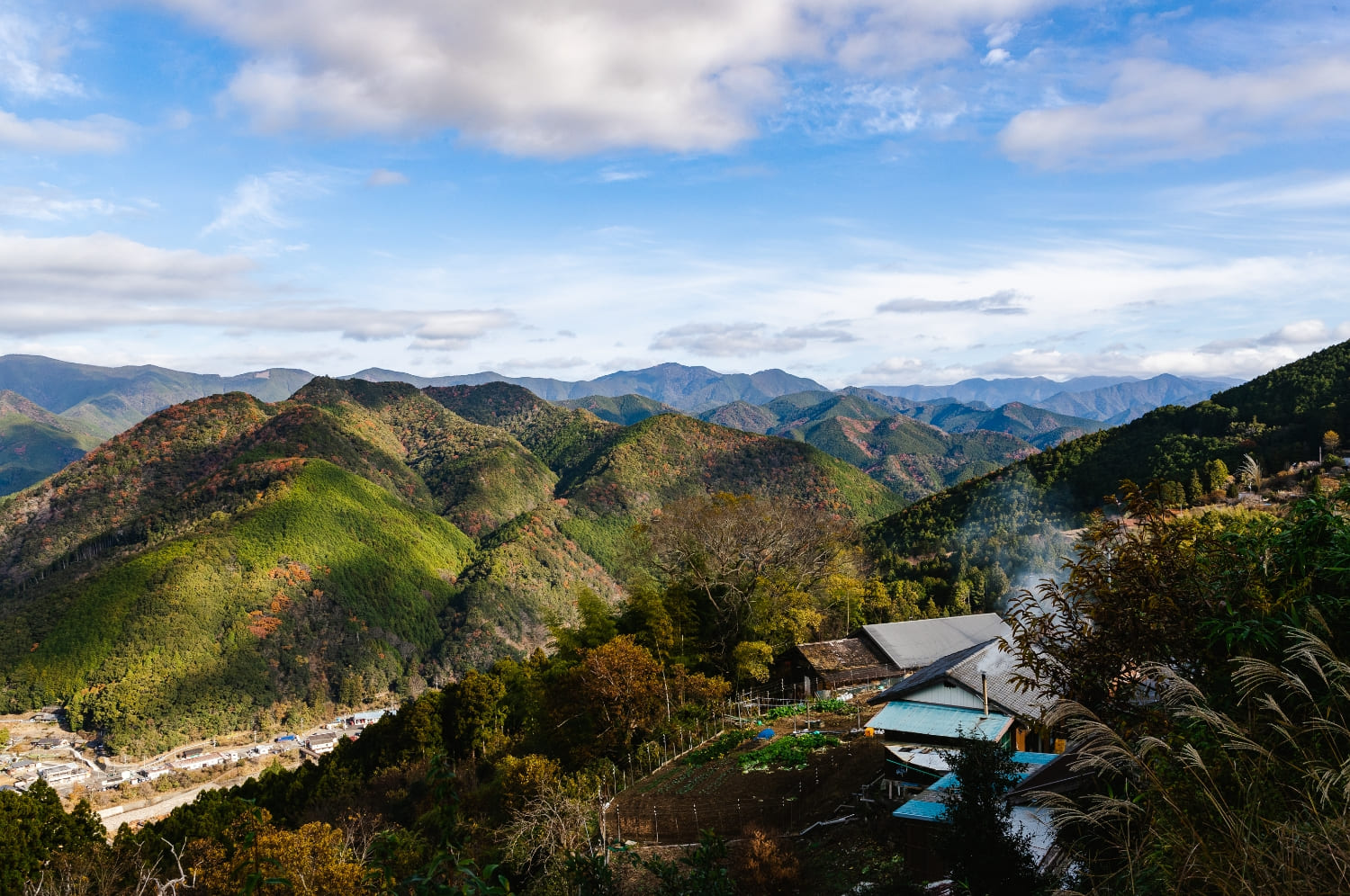
World Heritage of ‘Routes’: What is Kumano Kodo? Where is it? Introducing the must-see sights!
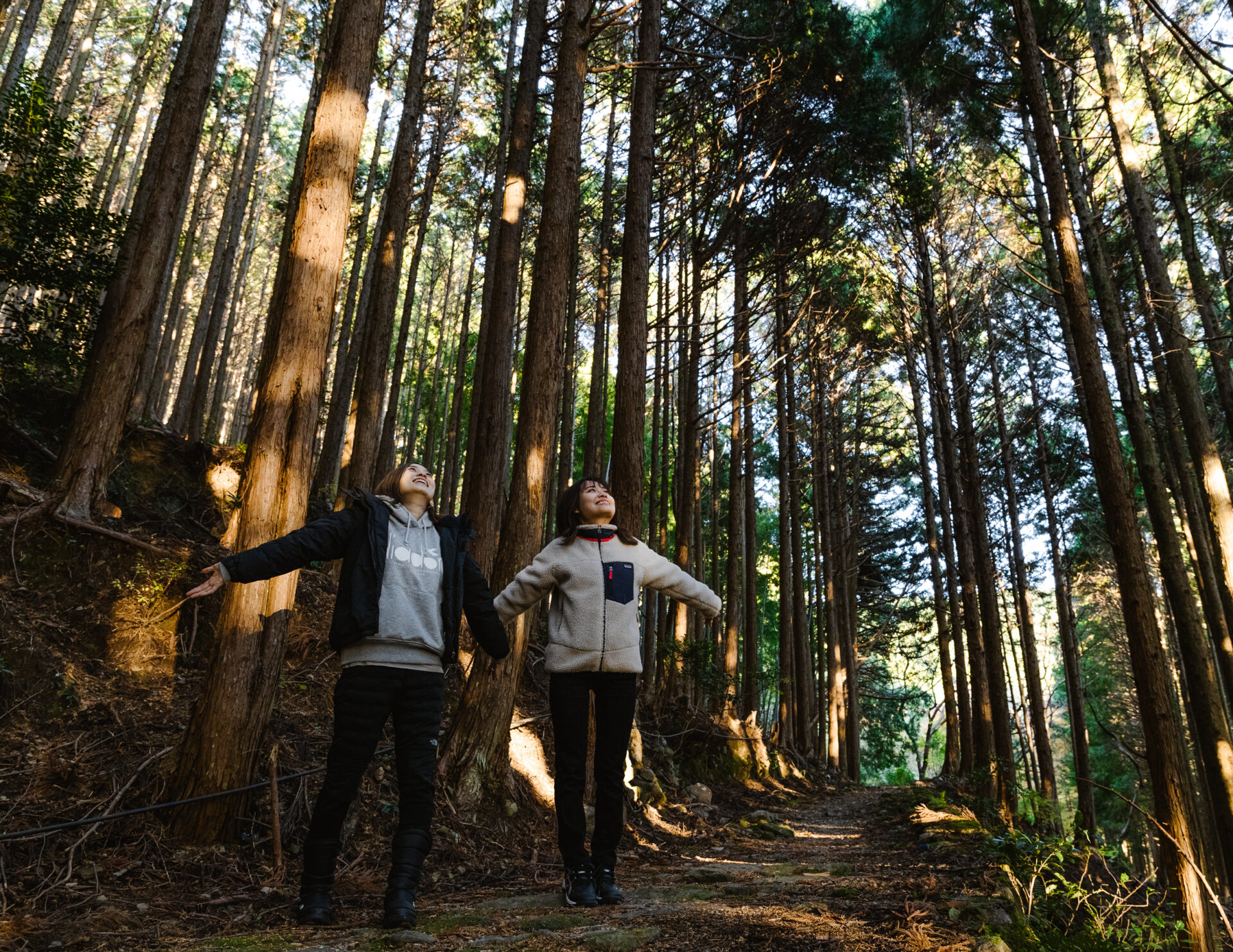
‘Kumano Kodo,’ which was registered as UNESCO World Heritage in 2004, is a pilgrimage route that pilgrims walked heading the Kumano Sanzan (Kumano Hongu Taisha, Kumano Nachi Taisha, and Kumano Hayatama Taisha) in Wakayama Prefecture. A network of ancient pilgrimage trails known as Kumano Moude’s course is attracting attention even in the modern days and is visited by many people from all over the country. It is recommended as a place to travel where you can get away from the busy city and rediscover yourself in nature.
The rivers, waterfalls, and rocks of the Kumano Kodo are said to have gods dwelling in them, and it is also called the “Land of Resurrection” due to its roots in worshiping nature.
In this article, we will introduce what kind of place Kumano Kodo is, where the route starts and ends, and also the must-see sights for those who visit for the first time.
What is Kumano Kodo? Where is it?
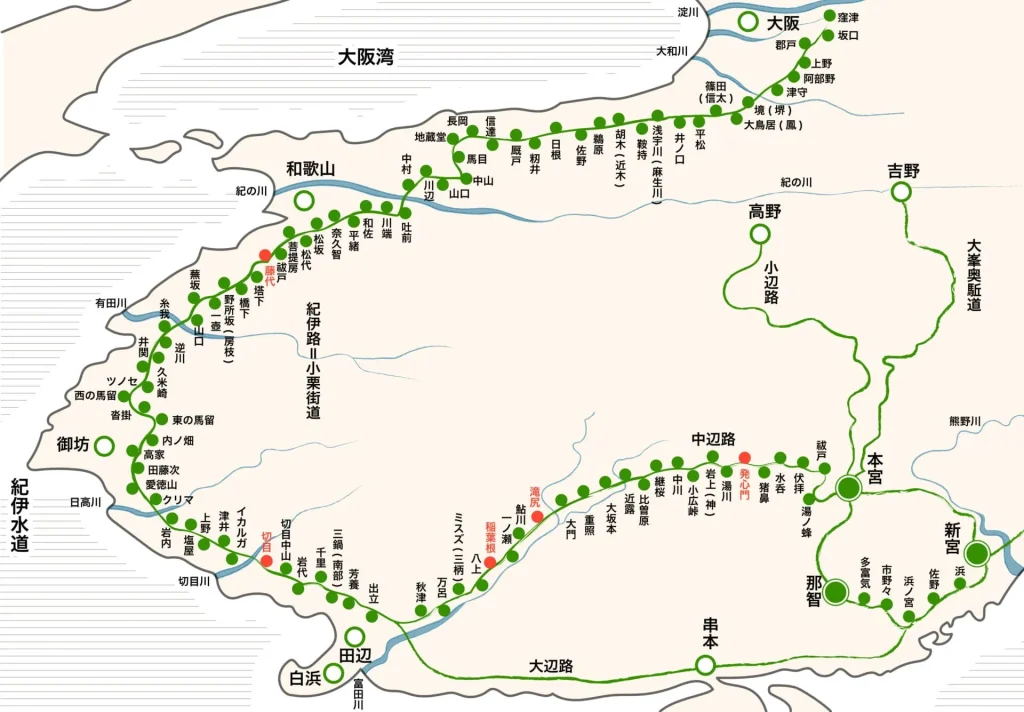
As you can see from the map above, ‘Kumano Kodo’ covers a wide area and has many forks in the road. The total length is said to be 600km. Most parts of the route are in the Wakayama Prefecture, but it is an old route that covers four prefectures including Mie, Nara, and Osaka Prefecture. Kumano Kodo can be divided into 5 main routes. This will be explained in detail later in the article.
The history of Kumano Kodo goes back to the Heian period. For ‘Kumano Moude’ which is the action of visiting the three shrines called “Kumano Sanzan,” the action of walking itself was considered a mountain ascetic practice. Aiming the Kumano Sanzan, people walked regardless of their status, age, and gender. At that time, it was a life-threatening journey that took a month to round trip from Kyoto.
Even today, Kumano Kodo has ancient shrines and nature remaining, which makes it meaningful both historically and as a natural scenery. Since it has been registered as a World Heritage, many people visit from all over Japan and the world. Those who are a beginner at trekking can use the bus or a car to visit tourist spots, and those who are confident in their physical strength can walk the entire route over several days. We also recommend relaxing your tired body in hot springs such as Katsuura Onsen and Yunomine Onsen, which can be found along the Kumano Kodo.
For Kumano Kodo’s history, check this article out for details.
What is Kumano Sanzan, the center of Kumano Kodo? Introducing photogenic spots.

We have introduced Kumano Kodo as the route that connects the Kumano Sanzan. Then, what is Kumano sanzan?
Kumano Sanzan refers to three shrines: Kumano Hongu Taisha, Kumano Nachi Taisha, and Kumano Hayatama Taisha. Originally, the gods of Kumano originated from worshipping nature, and each was independent. However, from the Nara period to the Heian period, the idea of syncretism of Shinto and Buddhism which considers God=Buddha, spread, and the three mountains influenced by this came to enshrine 12 common gods (which is Buddha). Kumano Sanza is the headquarters of approximately 400 shrines that exist around the country.
Let’s look in detail at the location, access, and history of each shrine.
Kumano Hongu Taisha

The first place to introduce is the Kumano Hongu Taisha which is the center of the Kumano pilgrimage. It takes about 2 hours by bus from the JR Kiitanabe Station, and about 2.5 hours (7km) by foot from a shrine called Hosshinmon-oji.
As you climb the 158 stone steps that lead to the main shrine, you will see the shrine building with its solemn cypress bark roof.
The three rivers flow around the area which are the Kumano River, the Otonashi River, and the Yomura River, and the scenery is breathtakingly beautiful during the cherry blossom and the autumn leaves seasons. Moreover, during the sunrise and sunset times, you can see a wonderful appearance that is different from the daytime.
According to the “Konendai Ryakusho” and “Jingu Engi,” the origin of Hongu Taisha is that the shrine building was built in 33 B.C. in Oyunohara, the middle state of three rivers. During the Heian period, the Imperial family and aristocrats took a month as a round trip to walk along Kumano Kodo from Kyoto to visit Hongu Taisha Shrine. The main enshrined deity was Susanoonomikoto. Since Kumano Hongu Taisha is composed of three shrines: upper, middle, and lower shrines, it is also called Kumano Sansho Gongen, or because the god worship is enshrined in the twelve temples, it is also called Kumano Juunisha Gongen.
The symbol is the Great Torii in Oyunohara. The Torii is 34 meters high, and it is the tallest in Japan. It is located about 500 meters away from the current main building and can be reached in about 10 minutes by foot, so try visiting. You will definitely be surprised at its size! We recommend the collaboration between the Great Torii and the cherry blossoms in spring.
In the Meiji period, the main shrine was equipped with a Noh stage, making it about eight times larger than it is now, but in 1889, Oyunohara was severely damaged by a flood, and the upper four shrines were relocated from Oyunohara to its current location in 1891. In the present, there are the middle four shrines, the lower four shrines, and the subsidiary shrine in Oyunohara.
Even in the Heisei era, Oyunohara and Zuihoden were severely damaged again by the Kii Peninsula flood, but in 2014, Zuihoden was rebuilt and reconstructed.
Official Site
Visiting Hours
8:00~17:00
Admission Fee
Free(For the Treasure Hall Adults: 300 yen Children: 100yen)
Kumano Nachi Taisha
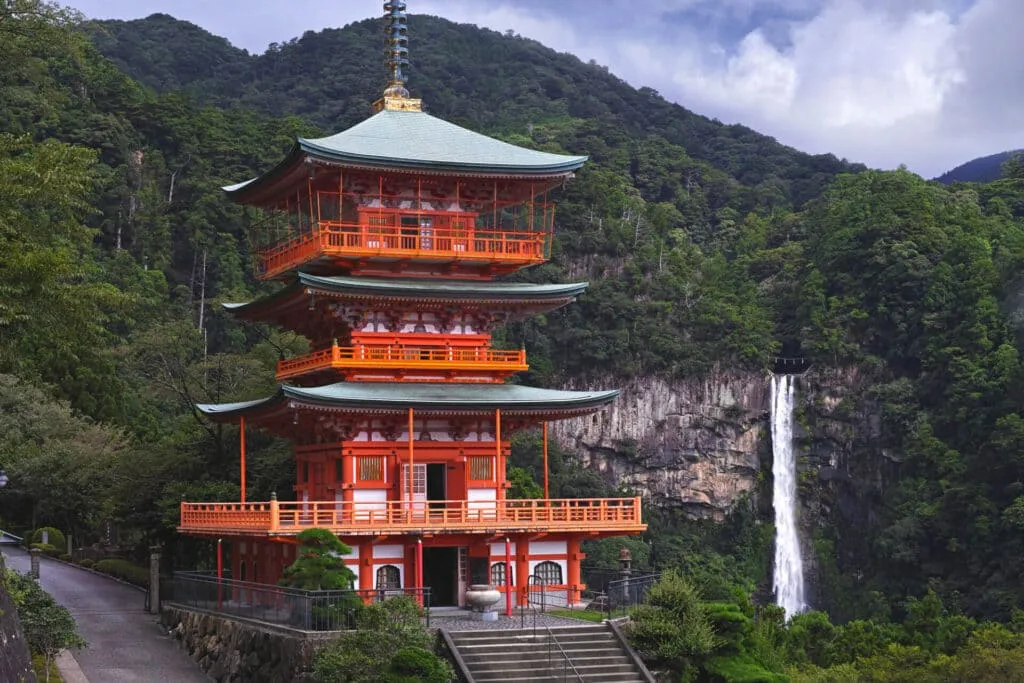
Kumano Nachi Taisha is a shrine located at the southern end of the Kii Peninsula known for its Nahi Falls. JR Kii Katsuura Station is the nearest station, and it takes about 30 minutes by bus from the station, but you can also enjoy trekking about 7.4 kilometers from the station.
Kumano Nachi Taisha consists of a main hall, a front hall, and a treasure hall, and the main hall is constructed with five temples in the front and one on the left. In addition, Yatagarasu, a three-legged crow sent by the gods of Kumano, is enshrined at Miagatahikosha Shrine in the precincts of Kumano Nachi Taisha Shrine. It is said that “Useki” in the precincts of the temple is a figure of Yatagarasu resting in a stone. Many of you probably know Yatagarasu as an emblem of the Japan Football Association.
In addition, the 850-year-old camphor tree is enshrined as a sacred tree, and the trunk is hollow, so you can go through it. If you bring a Gomagi (300 yen) or an ema (500 yen), you will feel sacred somehow.
There are many waterfalls in Nachi, where Kumano Nachi Taisha is located, and the highest waterfall among them is Nachi Falls (Nachi no Otaki). Also known as ‘Ichi no Taki,’ it is 133 meters high, Choushiguchi is 13 meters wide, the depth of the basin is more than 10 meters, and the amount of water flowing down is about 1 ton per second. The size of the scale is overwhelming. Nachi Falls is a symbolic site of Kumano Nachi Taisha, where gods were enshrined even before the shrine was built.
This waterfall is still believed to have the benefit of prolonging life, so if you pay the entrance fee, you can go quite close to the waterfall and get some water. The waterfall itself is enshrined as a god, and now it is called “Kumano Nachi Grand Shrine.”
There is a 1.3km stone-paved slope called “Daimonzaka” leading to the Kumano Nachi Taisha Shrine. You can enjoy Meotosugi, which are said to be 800 years old, as well as a row of 300-year-old cedar and camphor trees. If you walk for less than an hour from the entrance of Daimonzaka, you will arrive at Kumano Nachi Taisha, so this course is recommended for beginners of Kumano Kodo.
It is said that in 662 B.C., the group of Kamu-yamato-ihare-biko no Mikoto landed at Nishikiura (now Nachi no Hama). As the group headed toward the shining mountain, they found Nachi Falls and enshrined it as “the object of Onamuchi no kami.” It is said that the beginning of the Kumano Nachi Taisha Shrine was in 317 when the shrine was re-established halfway up the mountain. Seigantoji Temple, which forms the Kumano Sanzan along with Nachi Taisha, is near the Nachi Taisha so we recommend you visit there as well.
OfficOfficial Site
https://kumanonachitaisha.or.jp/
Visitng Hours
8:30~16:30
Admission Fee
Free(For the Treasure Hall Adults: 300 yen)
Kumano Hayatama Taisha
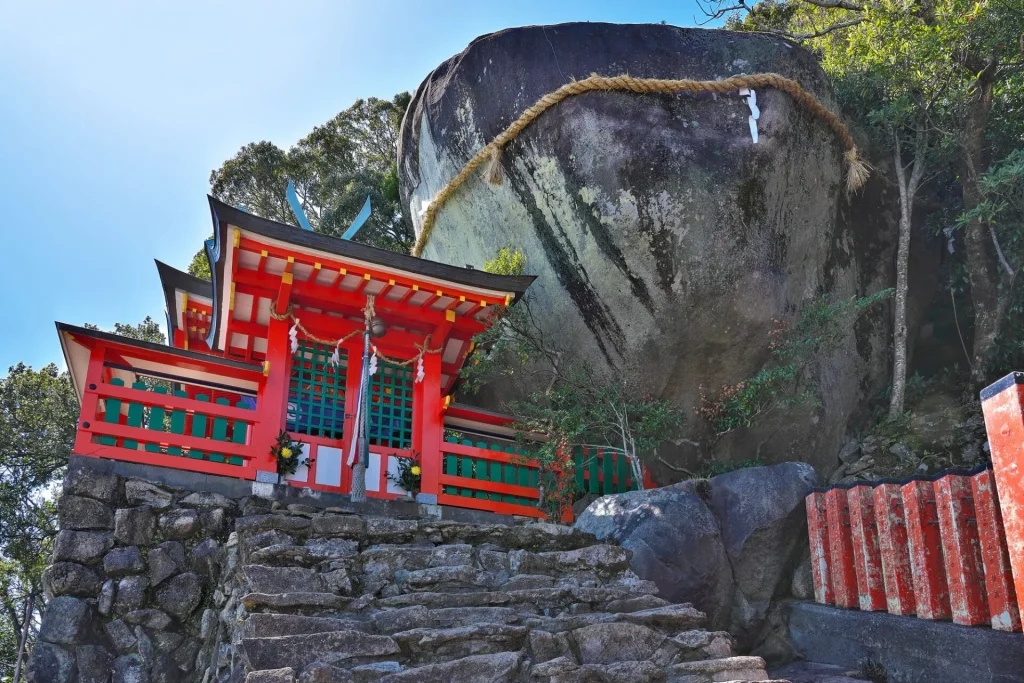
Among the Kumano Sanza, Kumano Hayatama Taisha is he closest to the sea and is located at the mouth of the Kumano River. JR Shingu Station is the nearest station and within walking distance.
With the Kumano River in the background, this large shrine has a vermilion-colored shrine and is dedicated to the couple gods: Kumano Hayatama no Okami and Kumano Fusumi no Okami. It is said that a shrine was built during the reign of Emperor Keikou to promote Kumano Gongen, who descended on Gotobiki rock at Kamikura Shrine.
The Gotobiki Iwa is up to eight meters wide and weigh as much as 200 kilograms. Incidentally, Gotobiki is a dialect referring to ‘toad.’ It is said to have been named because it resembles a toad in shape. There are 538 steps up to Gotobiki Iwa, built of natural stones, and you can see its sacredness.。
In addition, there is a giant 1,000-year-old willow tree designated as a natural monument in the precincts. It is a giant tree with a good history and is said to have been planted by Shigemori Tairano. It is said that it has the advantage of harmonious marital relations derived from the symmetrical shape of the leaves. There is also the Kumano Shinpo-kan, where 1,200 sacred treasures are displayed, and you can see Maki-e boxes and cypress hand fans from the Muromachi period.
Official Site
Visiting Hours
Sunrise to sunset (Conferment: 8:00-17:00)
Admission Fee
Free(神宝館は500円)
Why was Kumano Kodo chosen as a World Heritage Site?
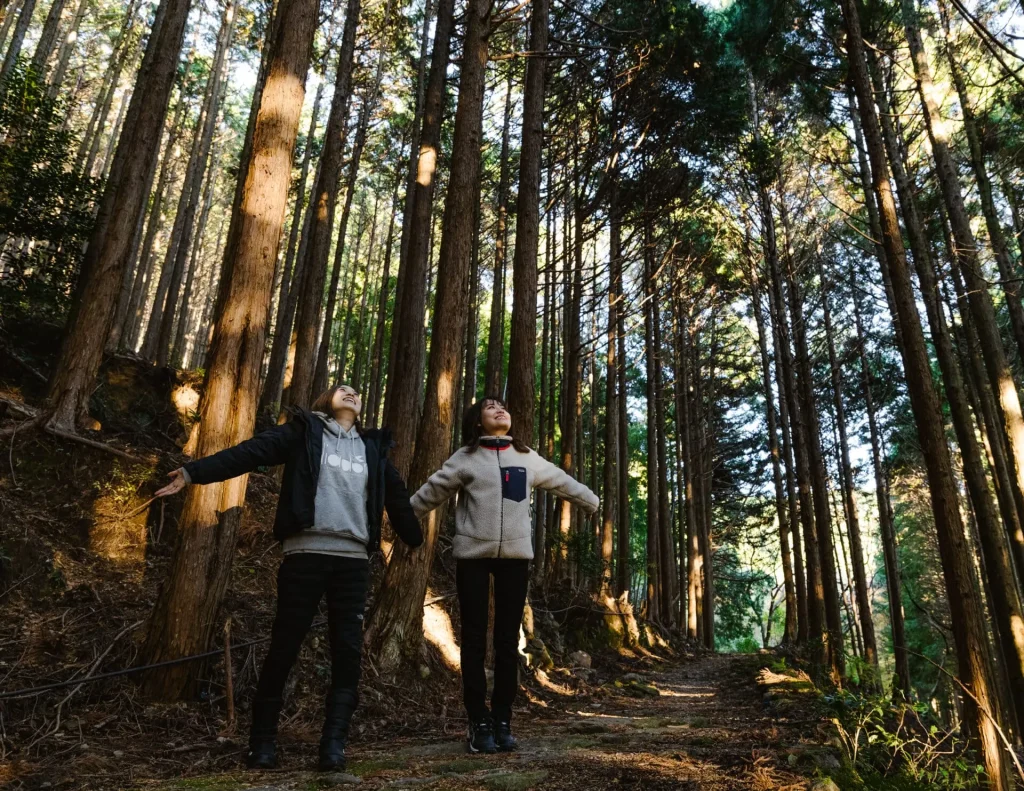
The “Holy Grounds and Pilgrimage Routes of the Kii Mountain Range” was registered as a World Heritage Site in 2004 – Kumano Kodo. It is the first cultural landscape in Japan to be listed on the World Heritage List. The reason why it was registered as a World Heritage Site is that ” The sites and their surrounding forest landscape reflect a persistent and extraordinarily well-documented tradition of sacred mountains. The area, with its abundance of streams, rivers, and waterfalls, is still part of the living culture of Japan.” (UNESCO World Heritage website).
In fact, only two places in the world have been registered as World Heritage Sites of a “route.” Kumano Kodo is the second world heritage site after the Camino de Santiago routes in Spain and France.
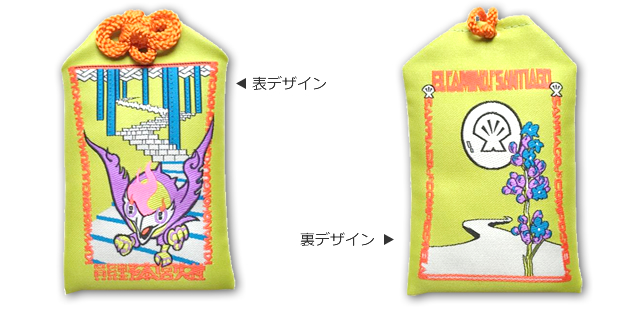
At Kumano Hongu Taisha, you can get amulets that are a collaboration with Santiago de Compostela. It was designed by Hirohiko Araki, a cartoonist who drew “Jojo’s Bizarre Adventure.” Mr. Araki has visited Kumano Kodo and Kumano Hongu Taisha many times and has decided to share his skills. This amulet, which contains a wish for “harmony” among people all over the world, reminds us of the heart that is needed in today’s world.
The reason why it was selected as a World Heritage Site is explained in detail in this article.
Which route do we recommend? Five routes connecting the Kumano Sanzan

The Kumano Kodo surrounding the Kumano Sanzan that we introduced is divided into five main routes. Let’s take a look at the characteristics of each.
Choose a route to visit based on your physical strength and the scenery you want to see.
Nakahechi
Nakahechi is one of the five Kumano Old Roads that have been walked by the most people. It is a 105km long road from Tanabe to Kumano Hongu Taisha, Shinnomiya, and Nachi. In the “Kumano Gokou” held between the Heian and Kamakura Period, Nakahechi was the official pilgrimage route.
Iseji
“Iseji” refers to the route from Ise Grand Shrine to each shrine in Kumano Sanzan. On this road, you can enjoy a variety of landscapes, including a panoramic view of Kumanonada from the mountain pass and terraced rice paddies, which are said to be the best in Japan.
Kohechi
The 70-kilometer pilgrimage route connecting Koyasan and Kumano Hongu Taisha is called “Kohechi.”It is the shortest distance because it crosses the mountain range from the back of Mt. Koyasan, but it is the most difficult route because it crosses hills over 1,000-meter elevation like the Obako three times.
Kiiji
The route from Jonangu in Kyoto to Kumano Sanzan via Sakai City in Osaka and Kiitanabe is “Kiiji.” Historic temples and tasteful buildings line up along the route, and private houses such as the Nakasuji Family Former Residence are famous.
Ohechi
“Ohechi” is a 120 km route from Kiitanabe’s Toukeijinja via Nachi Katsuuracho, which runs south along the coast. When you look up, you can enjoy a panoramic view of the sea through the forested trees, which can only be enjoyed because it is at the seaside.
Walking along Kumano Kodo? Recommended course for beginners
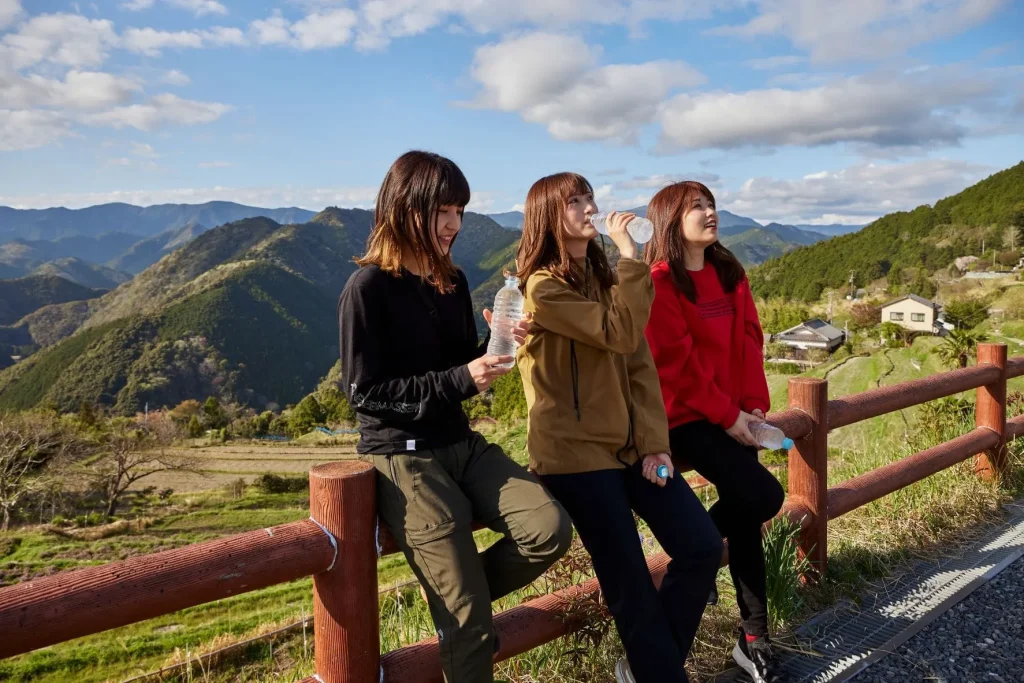
There is a recommended course for first-time visitors to Kumano Kodo.
[Nakahechi] Sangenjaya – Kumano Hongu Taisha
After all, if you want to visit Kumano Kodo, you should visit Nakahechi, where many people have walked since ancient times. The course from Sangenjaya to Kumano Hongu Taisha is about 4km long, aiming for Kumano Hongu Taisha, one of the Kumano Sanzan. It’s a gentle downhill, so even those who don’t have confidence in their physical strength can walk without worries.
The starting point, Sangenjaya, was named because there used to be three teahouses. Currently, there are rest areas and toilets modeled after the tea houses. Take a bus from JR Kiitanabe Station to the starting point. Get off at the Hiraiwaguchi bus stop.
Try stopping by the observatory on the way. It is a scenic spot that was selected as one of the “100 Best Sunsets in Wakayama Prefecture.” You can see Japan’s No. 1 Great Torii in Oyunohara from above.
The following article introduces many other recommended walking routes for beginners. Also, please refer to the items you need for trekking.
Recommended Accommodations along the Kumano Kodo
Along the Kumano Kodo, there are hot spring hotels and guest houses. There are not many, so for those who plan to travel during summer vacation or busy periods, we recommend making reservations early.








